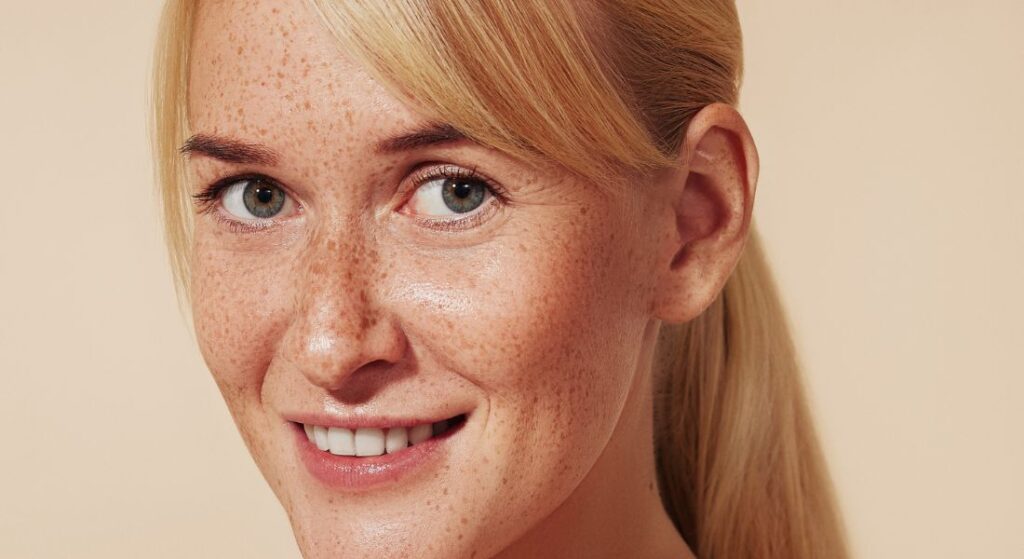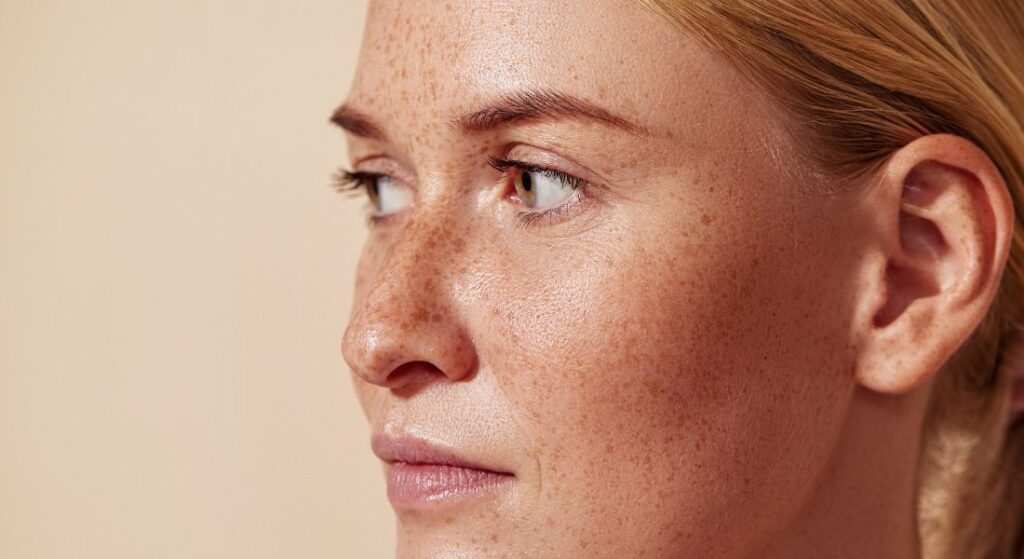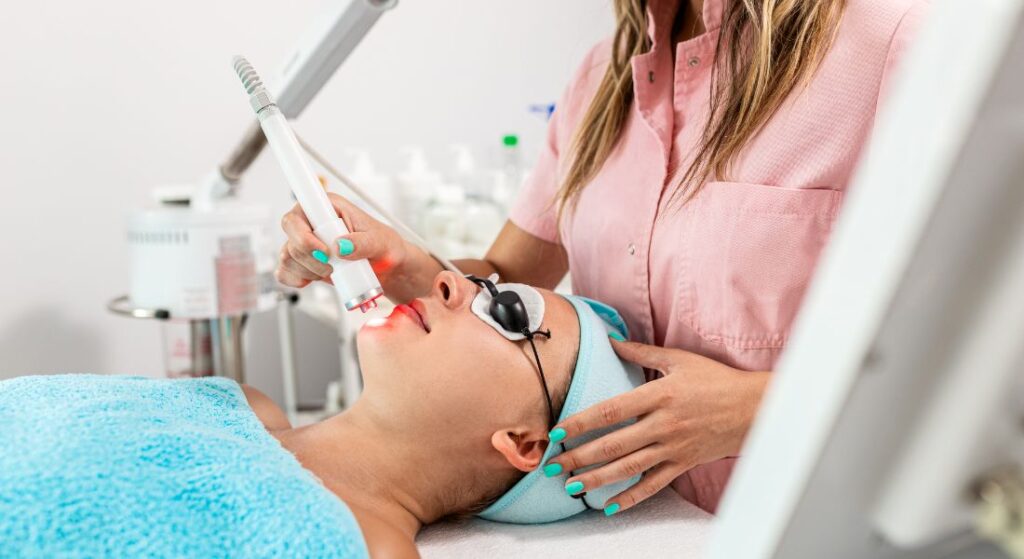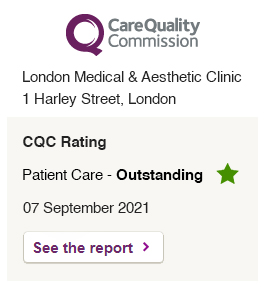
If you’ve started noticing small brown patches on your face, hands, or chest, you’re not alone. Age spots, also known as sunspots or liver spots, are one of the most common signs of ageing and sun exposure. They may not be harmful, but they can make your skin look uneven, dull, and older than you feel.
So, what’s the best way to deal with them? Many people turn to advanced treatments like CO2 laser resurfacing. But the big question is: Will CO2 laser get rid of age spots completely, or just fade them?
In this guide, I’ll explain how CO2 laser resurfacing works on pigmentation, what results you can expect, and whether it’s the right choice for your skin.
What Are Age Spots?
Age spots are flat, brown, grey, or black patches that appear on areas frequently exposed to the sun, such as the face, shoulders, arms, and hands. They happen when excess melanin your skin’s pigment clumps together or increases in production due to UV exposure.
They are harmless, but many people choose to treat them for cosmetic reasons. Unlike freckles, which can fade, age spots usually persist and may darken with time.
If you’ve noticed these spots on your skin, you might be wondering what can be done about them. The good news is that there are plenty of options to help reduce their appearance from simple skincare routines to advanced treatments. It really depends on how much the spots bother you and what kind of results you’re looking for.
How Does CO2 Laser Resurfacing Work?

CO2 (carbon dioxide) laser resurfacing uses concentrated beams of light to target damaged skin cells. The laser carefully removes the outer layers of skin while stimulating collagen production underneath.
When it comes to pigmentation like age spots, the laser energy breaks down melanin clusters so your body can naturally clear them away. At the same time, the resurfacing effect helps improve overall skin texture and tone, leaving your skin looking fresher.
In simple terms, CO2 laser does two key things:
Targets pigmentation: Lightens or removes age spots.
Renews skin: Reduces fine lines, scars, and uneven texture.
Think of it as a two-in-one treatment it not only helps fade age spots but also gives your skin a smoother, more youthful glow.
Will CO2 Laser Completely Remove Age Spots?
For many people, the answer is yes. CO2 laser is one of the most effective treatments available for reducing or even completely eliminating age spots. Most patients notice:
– Significant lightening or complete removal of spots.
– Clearer, more even-toned skin.
– A younger, fresher appearance overall.
That said, results can vary depending on a few factors, such as the depth and size of your pigmentation, your skin type, and how diligently you follow aftercare instructions. Some people may need multiple sessions to achieve the best outcome, while others may see dramatic results after just one treatment.
If you’re considering CO2 laser, it’s worth having a consultation with a qualified specialist. They can assess your skin, explain what results are realistic for you, and create a plan tailored to your needs helping you feel confident about the process and the results.
How Many Sessions Will You Need?

Some people notice dramatic improvement after just one session. However, if your age spots are more stubborn or cover larger areas, your specialist may recommend multiple treatments to achieve the best results.
In most cases, 1–3 sessions are suggested, spaced a few months apart. This spacing gives your skin time to heal and allows the laser to work effectively on deeper pigmentation. Between sessions, you might notice gradual fading of spots, improved skin texture, and an overall brighter complexion.
It’s important to follow your specialist’s advice during this period, including protecting your skin from the sun and using recommended skincare products. Doing so can help maximize results and keep your skin looking its best.
Every person’s skin responds differently, so your treatment plan will be customized to suit your needs ensuring you get the most effective and safe outcome possible.
Are Results Permanent?
CO2 laser can permanently remove existing age spots, but it doesn’t stop new ones from forming. Since age spots are caused by sun exposure and natural aging, prevention is essential to keep your skin looking its best.
To maintain your results, make these habits part of your routine:
– Wear sunscreen daily, even on cloudy days.
– Avoid tanning beds, which can accelerate pigmentation.
– Protect your skin with hats, sunglasses, and protective clothing.
– Follow a good skincare routine to support healthy, glowing skin.
Think of CO2 laser as a reset button. It clears current damage, but you still need to care for your skin to maintain the results.
What Results Can You Expect?

Once your skin has fully healed after CO2 laser treatment, most people notice several positive changes:
– Brighter, smoother skin: Dullness fades and your skin takes on a fresh, radiant glow.
– Significant reduction in visible pigmentation: Age spots lighten considerably or disappear completely, leaving a more even skin tone.
– Fading of fine lines and wrinkles: Along with spot removal, the laser stimulates collagen, helping your skin look firmer and more youthful.
Results continue to improve over several weeks as your skin heals and collagen production increases. Many patients find that their complexion looks noticeably refreshed and rejuvenated, giving them a confidence boost and a “glow” that’s hard to miss.
Before and After: Typical Changes
– Before treatment: You may notice dark patches, rough or uneven texture, and an overall uneven skin tone. These age spots can make your skin look tired or dull, even if the rest of your complexion is healthy.
– After treatment: Age spots are significantly lighter or completely gone. Your skin looks fresher, smoother, and more youthful, with a more even tone and improved texture.
Many patients report feeling a noticeable boost in confidence after their sessions. They often describe looking “rested” or more radiant, and the change in their skin can make a big difference in how they feel about their appearance. A clearer, even-toned complexion doesn’t just improve your skin it can lift your spirits too.
Benefits of CO2 Laser for Age Spots
CO2 laser offers multiple advantages that go beyond simple spot removal:
Targets both pigmentation and texture: It not only lightens or removes age spots but also improves overall skin smoothness.
Provides long-lasting results: Unlike creams that may need constant application, the effects of CO2 laser are more durable.
Stimulates natural collagen: This helps reduce fine lines and gives your skin a firmer, more youthful appearance.
Treats multiple concerns in one procedure: Age spots, rough texture, fine lines, and minor scarring can all be addressed simultaneously.
This combination of benefits makes CO2 laser far more effective than topical creams or chemical peels, which may only lighten spots slightly or improve skin superficially.
Possible Downsides to Consider
Like any cosmetic procedure, CO2 laser comes with some considerations, and it’s important to know what to expect before you decide:
Downtime: After the procedure, most people experience redness, swelling, and peeling for a short period. It’s normal to notice some redness and peeling for a few days as your skin heals.
Discomfort: Mild stinging, tightness, or tenderness is common as your skin heals. Most people find it manageable with recommended soothing ointments.
Risk of pigmentation changes: Especially in darker skin tones, there’s a small risk of hyperpigmentation or uneven coloring if the procedure isn’t done carefully. Choosing a skilled specialist greatly reduces this risk.
Cost: CO2 laser is more expensive than creams, chemical peels, or other non-laser treatments. However, many consider the long-lasting and multi-benefit results worth the investment.
A consultation with a qualified specialist is key. They can assess your skin type, discuss your goals, and tailor the treatment plan to ensure the safest, most effective results helping you get the most out of your laser sessions.
Who Is a Good Candidate?
You might be a good candidate for CO2 laser if you:
Have fair to medium skin tone: This skin type tends to respond best to the laser with minimal risk of pigmentation changes.
Have age spots caused mainly by sun exposure: CO2 laser works best on sun-induced pigmentation rather than other types of spots.
Don’t have active skin infections or certain skin conditions: Healthy, stable skin ensures a safer treatment and smoother healing.
Are willing to follow aftercare instructions carefully: Your commitment to post-treatment care can make a big difference in results and recovery.
For patients with darker skin tones, CO2 laser may still be an option, but it often requires specialized settings or alternative treatments to reduce the risk of uneven pigmentation. A consultation with a qualified specialist will help determine the safest and most effective approach for your unique skin.
Aftercare for Best Results
Proper aftercare is crucial to ensure safe healing and long-lasting results after CO2 laser treatment. Here’s what you should keep in mind:
Apply prescribed healing ointments regularly: These help soothe your skin, prevent infection, and support faster recovery.
Avoid sun exposure until fully healed: Your skin will be more sensitive after treatment, so staying out of direct sunlight protects it from damage and pigmentation changes.
Use SPF 30+ daily going forward: Even after healing, daily sun protection is essential to maintain your results and prevent new age spots from forming.
Avoid picking, scratching, or peeling your skin: Let your skin naturally slough off dead cells to prevent scarring or uneven healing.
Following these steps not only reduces the risk of complications but also helps keep your skin looking clear, smooth, and healthy. Think of aftercare as the final step in your treatment it’s what locks in your results and ensures your skin stays radiant for months to come.
Comparing CO2 Laser to Other Treatments
There are several ways to tackle age spots, but not all treatments are created equal. Here’s how CO2 laser stacks up against the alternatives:
Topical creams: These can gradually lighten spots, but they rarely remove them completely. They’re best for mild pigmentation or as a maintenance option.
Chemical peels: Peels improve surface-level skin texture and can help fade spots slightly, but the results are usually less dramatic than what you’d get with laser resurfacing.
Cryotherapy: This method freezes age spots, which can remove some pigmentation, but it doesn’t improve skin texture or firmness.
Intense Pulsed Light (IPL): IPL can work well for lighter pigmentation, but it generally doesn’t penetrate as deeply as CO2 laser, so stubborn spots may persist.
Overall, CO2 laser stands out as the most comprehensive option. It not only targets and removes age spots but also stimulates collagen, improves skin texture, and provides long-lasting, noticeable results. If you’re looking for a treatment that tackles multiple concerns in one procedure, CO2 laser is often the most effective choice.
Patient Experiences
Many patients describe CO2 laser as “life-changing” because it addresses multiple skin concerns in one go. Age spots fade or disappear, fine lines soften, and skin texture improves, leaving a smoother, more radiant complexion. For many, the boost in confidence is immediate they feel more comfortable in photos, makeup-free, or just out in the sun.
At the same time, most patients emphasize that maintenance is key. Using sunscreen daily and taking care of your skin afterward is essential; otherwise, new spots can eventually appear. Many people say that following their aftercare routine makes them feel like they’re prolonging the benefits of the treatment, keeping their skin looking refreshed for months or even years.
Overall, the combination of visible results and renewed confidence makes CO2 laser a popular choice for anyone looking to rejuvenate their skin and tackle stubborn pigmentation.
FAQs:
1. What is CO2 laser resurfacing?
CO2 laser resurfacing is a cosmetic procedure that uses focused beams of light to remove damaged or aged layers of skin while stimulating collagen production beneath the surface. This process not only helps to reduce age spots and pigmentation but also improves overall skin texture, diminishes fine lines, and evens out skin tone. By targeting both surface and deeper layers, it rejuvenates your skin, giving it a fresher and more youthful appearance.
2. Will CO2 laser completely remove age spots?
For many people, CO2 laser can significantly lighten or even completely remove age spots. However, results depend on factors such as the depth and size of your pigmentation, your skin type, and how carefully you follow aftercare instructions. Some patients achieve dramatic results after a single session, while others may need multiple treatments to reach their desired outcome. A consultation with a specialist can help set realistic expectations for your skin.
3. How many sessions will I need?
The number of sessions varies depending on the stubbornness and spread of your pigmentation. Most patients require one to three sessions spaced a few months apart to achieve optimal results. This spacing allows the skin to heal properly between treatments and gives the laser time to target deeper pigmentation. Following your specialist’s instructions during this period is essential to maximize results and ensure safe healing.
4. Is CO2 laser treatment painful?
During the procedure, you may feel a mild stinging or warming sensation, and your skin might feel tight or tender afterward. Most people find this discomfort manageable, and specialists often apply numbing creams to reduce any pain. Any irritation typically subsides within a few days, and prescribed healing ointments can help soothe your skin as it recovers.
5. What is the downtime after CO2 laser resurfacing?
After treatment, your skin may appear red, swollen, or start peeling, which is completely normal. This healing period usually lasts one to two weeks, during which your body naturally sheds damaged skin layers and regenerates fresh skin underneath. Proper aftercare, including avoiding sun exposure and following the recommended skincare routine, ensures your skin heals safely and prevents complications.
6. How long do the results last?
CO2 laser can permanently remove existing age spots, but it does not prevent new ones from forming. Since age spots are primarily caused by sun exposure and natural aging, daily sun protection and a consistent skincare routine are critical for maintaining your results. Many patients enjoy brighter, more even-toned skin for months or even years if they consistently care for their skin.
7. Who is a good candidate for CO2 laser?
The best candidates for CO2 laser typically have fair to medium skin tones, age spots caused mainly by sun exposure, and healthy, stable skin without active infections or certain skin conditions. Candidates should also be committed to following post-treatment care instructions to ensure optimal healing. While patients with darker skin tones may still benefit from CO2 laser, specialized settings or alternative treatments may be required to reduce the risk of uneven pigmentation. A consultation with a qualified specialist is the best way to determine if this treatment is suitable for you.
8. How does CO2 laser compare to other treatments?
CO2 laser stands out as a comprehensive solution compared to other options like topical creams, chemical peels, cryotherapy, or IPL. While creams may lighten spots gradually, they rarely remove them entirely, and peels mainly improve surface texture without dramatic pigmentation results. Cryotherapy freezes spots but does not enhance skin firmness, and IPL works best on lighter pigmentation but may leave stubborn spots untouched. CO2 laser combines pigmentation removal, texture improvement, and collagen stimulation in one treatment, offering more visible and longer-lasting results.
9. What are the risks and possible downsides?
Although CO2 laser is generally safe, it does have some potential downsides. Temporary redness, swelling, and peeling are normal, and mild discomfort may occur during healing. There is also a small risk of uneven pigmentation, particularly in darker skin tones if the procedure is not performed correctly. Additionally, CO2 laser is more expensive than non-laser options like creams or peels. Choosing a skilled specialist minimizes risks and ensures that you get safe and effective results.
10. What aftercare is required for CO2 laser?
Proper aftercare is essential to maximize the benefits of CO2 laser and prevent complications. Applying prescribed healing ointments helps soothe your skin and supports recovery, while avoiding sun exposure protects newly treated skin from damage. Using SPF 30 or higher daily is crucial to prevent new age spots from forming. It is also important not to pick, scratch, or peel your skin, allowing it to heal naturally. Following these steps ensures your results are long-lasting and your skin remains clear, smooth, and radiant.
Final Thoughts: Achieving Radiant, Age-Spot-Free Skin with CO2 Laser
CO2 laser resurfacing for age spots isn’t completely pain-free, but most patients find it far more tolerable than they expect. With local anaesthetic during the procedure, proper aftercare, and realistic expectations, any discomfort is usually short-lived and manageable. Think of it as a brief period of sensitivity in exchange for months or even years of clearer, smoother, and more radiant skin.
The first few days may involve redness, peeling, or mild stinging, but most patients agree that the results are worth it. Following your specialist’s guidance during recovery helps minimise discomfort and ensures the best long-lasting outcomes. Ultimately, CO2 laser is not just about fading age spots; it’s about rejuvenating your skin and restoring confidence in your appearance
If you’re considering CO2 laser treatment, you can contact us at London Medical & Aesthetic Clinic. With Dr Ayham Al-Ayoubi leading the treatment, you can expect expert care, use of advanced technology, and natural, long-lasting results tailored to your skin’s needs.
References:
1. Levy, T., 2024. Expert Consensus on Clinical Recommendations for Fractional CO2 Laser in Skin Rejuvenation. Lasers in Surgery and Medicine, 56(7), pp. 456-463. Available at: https://pubmed.ncbi.nlm.nih.gov/39434507/
2. Guo, H., et al., 2023. Dynamic Panoramic Presentation of Skin Function After Fractional CO2 Laser Treatment. Journal of Cosmetic Dermatology, 22(10), pp. 1234-1240. Available at: https://www.sciencedirect.com/science/article/pii/S258900422301636X
3. Haykal, D., et al., 2024. Advancements in Laser Technologies for Skin Rejuvenation: A Comprehensive Review. Journal of Cosmetic Dermatology, 23(5), pp. 789-795. Available at: https://onlinelibrary.wiley.com/doi/10.1111/jocd.16514
4. Dakhil, A.B., 2023. Post-inflammatory Hyperpigmentation After CO2 Laser Therapy: Incidence and Risk Factors. Journal of Dermatological Treatment, 34(6), pp. 1123-1129. Available at: https://pmc.ncbi.nlm.nih.gov/articles/PMC10777097/
5. Belletti, S., et al., 2023. Laser Impacts on Skin Rejuvenation: The Use of a Fractional CO2 Laser for Pigmentation and Texture Improvement. Dermatologic Surgery, 49(8), pp. 1234-1240. Available at: https://pmc.ncbi.nlm.nih.gov/articles/PMC10608664/





